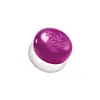What's inside
What's inside
 Key Ingredients
Key Ingredients

No key ingredients
 Benefits
Benefits

 Concerns
Concerns

 Ingredients Side-by-side
Ingredients Side-by-side

Mica
Cosmetic ColorantCI 77891
Cosmetic ColorantDimethicone
EmollientCaprylic/Capric Triglyceride
MaskingDiisostearyl Malate
EmollientMethyl Methacrylate Crosspolymer
Dimethicone/Vinyl Dimethicone Crosspolymer
Skin ConditioningCyclopentasiloxane
EmollientMicrocrystalline Wax
Emulsion StabilisingCI 77492
Cosmetic ColorantSorbitan Olivate
EmulsifyingCI 15985
Cosmetic ColorantAcrylates/Dimethicone Copolymer
Skin ConditioningCI 45410
Cosmetic ColorantCI 77491
Cosmetic ColorantSorbitan Isostearate
EmulsifyingTriethoxycaprylylsilane
Aluminum Hydroxide
Emollient1,2-Hexanediol
Skin ConditioningSilica
AbrasiveDiethylhexyl Syringylidenemalonate
Skin ProtectingIsoceteth-10
EmulsifyingMica, CI 77891, Dimethicone, Caprylic/Capric Triglyceride, Diisostearyl Malate, Methyl Methacrylate Crosspolymer, Dimethicone/Vinyl Dimethicone Crosspolymer, Cyclopentasiloxane, Microcrystalline Wax, CI 77492, Sorbitan Olivate, CI 15985, Acrylates/Dimethicone Copolymer, CI 45410, CI 77491, Sorbitan Isostearate, Triethoxycaprylylsilane, Aluminum Hydroxide, 1,2-Hexanediol, Silica, Diethylhexyl Syringylidenemalonate, Isoceteth-10
Dimethicone
EmollientDimethicone Crosspolymer
Emulsion StabilisingTribehenin
EmollientPolyglyceryl-2 Triisostearate
EmulsifyingSynthetic Fluorphlogopite
Diisostearyl Malate
EmollientTheobroma Cacao Seed Butter
EmollientAgave Tequilana Leaf Extract
AstringentCetyl PEG/PPG-10/1 Dimethicone
EmulsifyingSorbitan Isostearate
EmulsifyingVinyl Dimethicone/Methicone Silsesquioxane Crosspolymer
Polyhydroxystearic Acid
EmulsifyingPolyglyceryl-2 Diisostearate
EmulsifyingDisteardimonium Hectorite
StabilisingEthylhexyl Palmitate
EmollientIsopropyl Myristate
EmollientIsostearic Acid
CleansingLecithin
EmollientPolyglyceryl-3 Polyricinoleate
EmulsifyingTriethyl Citrate
MaskingCaprylyl Glycol
EmollientGlyceryl Caprylate
EmollientButylene Glycol
HumectantWater
Skin ConditioningParfum
MaskingCI 17200
Cosmetic ColorantCI 15985
Cosmetic ColorantCI 77491
Cosmetic ColorantCI 45410
Cosmetic ColorantCI 77891
Cosmetic ColorantCI 15850
Cosmetic ColorantCI 42090
Cosmetic ColorantCI 19140
Cosmetic ColorantDimethicone, Dimethicone Crosspolymer, Tribehenin, Polyglyceryl-2 Triisostearate, Synthetic Fluorphlogopite, Diisostearyl Malate, Theobroma Cacao Seed Butter, Agave Tequilana Leaf Extract, Cetyl PEG/PPG-10/1 Dimethicone, Sorbitan Isostearate, Vinyl Dimethicone/Methicone Silsesquioxane Crosspolymer, Polyhydroxystearic Acid, Polyglyceryl-2 Diisostearate, Disteardimonium Hectorite, Ethylhexyl Palmitate, Isopropyl Myristate, Isostearic Acid, Lecithin, Polyglyceryl-3 Polyricinoleate, Triethyl Citrate, Caprylyl Glycol, Glyceryl Caprylate, Butylene Glycol, Water, Parfum, CI 17200, CI 15985, CI 77491, CI 45410, CI 77891, CI 15850, CI 42090, CI 19140
 Reviews
Reviews

Ingredients Explained
These ingredients are found in both products.
Ingredients higher up in an ingredient list are typically present in a larger amount.
Ci 15985 is a dye made from petroleum. It is synthetically created and approved by the FDA for use in foods and cosmetics.
The color of this dye is orange/yellow.
This ingredient can be found in makeup, sun care, and skincare.
Learn more about CI 15985CI 45410 is a synthetic red-pigment and dye.
It often goes by both Red 28 or Red 27; manufacturers label both ingredients as CI 45410.
This dye is commonly found in makeup because it imparts a vivid color. Some types of this dye change color based on pH level and interaction with moisture:
Your skin has a natural pH of around 4.5 - 5.5.
According to the FDA, CI 45410 is not permitted for use in eye products.
Red 27 is a flourescein dye and commonly used as a fluorescent tracer in medicine.
Learn more about CI 45410Ci 77491 is also hydrated iron III oxide. It's sole purpose is to give a red/pink hue to products.
Iron III oxides are classified as inorganic chemicals for coloring.
Synthetically created Ci 77491 is considered safer than those naturally found. This is because the synthetically created version may contain less impurities. Iron oxides are generally non-toxic and non-allergenic.
Learn more about CI 77491Ci 77891 is a white pigment from Titanium dioxide. It is naturally found in minerals such as rutile and ilmenite.
It's main function is to add a white color to cosmetics. It can also be mixed with other colors to create different shades.
Ci 77891 is commonly found in sunscreens due to its ability to block UV rays.
Learn more about CI 77891Diisostearyl Malate is an emollient and most often used in lip products. It comes from isostearyl alcohol, a fatty acid, and malic acid, an AHA.
As an emollient, Diisostearyl Malate helps create a thin film on your skin to trap moisture in. This helps keep your skin soft and smooth.
Dimethicone is a type of synthetic silicone created from natural materials such as quartz.
What it does:
Dimethicone comes in different viscosities:
Depending on the viscosity, dimethicone has different properties.
Ingredients lists don't always show which type is used, so we recommend reaching out to the brand if you have questions about the viscosity.
This ingredient is unlikely to cause irritation because it does not get absorbed into skin. However, people with silicone allergies should be careful about using this ingredient.
Note: Dimethicone may contribute to pilling. This is because it is not oil or water soluble, so pilling may occur when layered with products. When mixed with heavy oils in a formula, the outcome is also quite greasy.
Learn more about DimethiconeSorbitan Isostearate is an emulsifer and cleaning agent. It is created from isostearic acid and sorbitol.
As an emulsifier, Sorbitan Isostearate prevents oils and water from separating.
Due to its isostearic acid base, it may not be safe for Malassezia or fungal acne.
Learn more about Sorbitan Isostearate